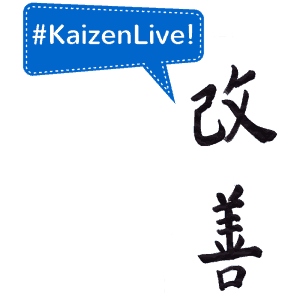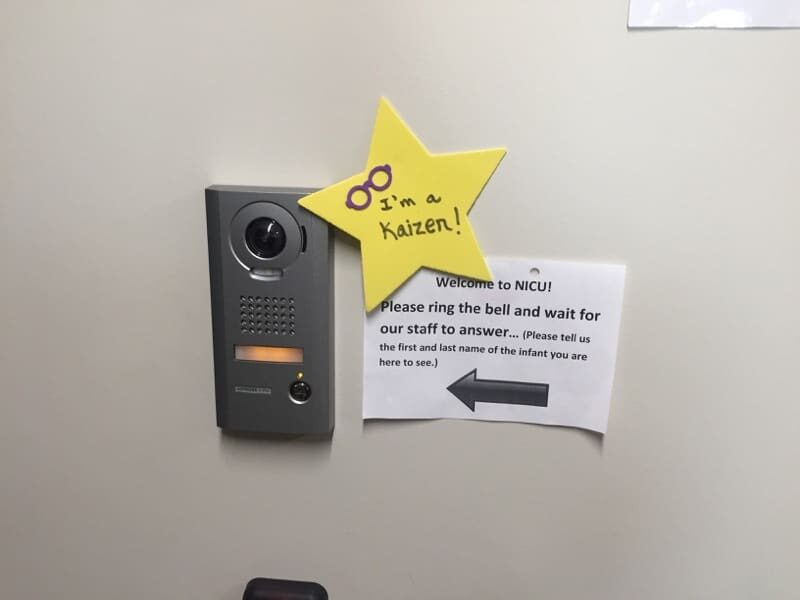
In my first post about the on-site Kaizen learning experience at Franciscan St. Francis Health, an event I came to call “Kaizen Live,” I wrote about some of the initial presentations and discussions from Franciscan leaders. You can also see my tweets from the days.
A big part of the 1.5-day event was the three “gemba visits” that took place. Each attendee had the chance to visit pharmacy, endoscopy, and the NICU. I had visited all three departments before (when we shot this series of videos last October) and I focused this time on the NICU, going there all three times. Why did I go three times? Some of it was logistics, as I was the person responsible for getting each group there and I don't know my way around the hospital that well. It was easier to learn one path – how to get to the NICU and back.
Since my last visit in October 2014, the NICU moved into a new physical space (in November). The old unit was the traditional NICU of days past – a big open room with curtains that divided the space for each infant incubator, but didn't provide too much privacy. The new, modern NICU was built with private rooms with sliding glass doors – providing more quiet and privacy than before.
While the NICU team had implemented hundreds of Kaizens in previous years, the chance to design a brand new space was a rare opportunity for radical Kaizen, or what might be called “Kaikaku.” Since it's difficult to continuously improve many elements of a physical layout (such as the location of walls), the team experimented with full-size Styrofoam mockups of the space. Staff and parents were able to give input at a stage when you could still Adjust easily in the PDSA model of Plan, Do, Study, Adjust.
Even with that design input and iteration, there were, of course, Kaizen opportunities that presented themselves in the new space.
Listen to Mark read this post (subscribe here):
Better, Not Perfect
One was sign that was installed by the security intercom that visitors need to use to gain access to the unit. Visitors most often missed seeing the box or they didn't know what it was. So, since it's difficult and expensive to move that box (a problem that wasn't anticipated in the mockup phase, unfortunately), they added a sign. This sign is a temporary countermeasure that will eventually be replaced with a more official looking sign. It's not ideal, but it's better than it was.

That intercom box is just one way in which the NICU takes security seriously. One of their first Kaizens was initiated by a unit secretary to make it easier to look up and reference the list of approved visitors or people who needed to be specifically kept out because of security concerns with a particular baby. That's a great example of people working on the Kaizens that matter to staff and their patients. Nobody insisted on an ROI calculation for a Kaizen that made work a little easier and probably helped ensure safety and security.
You probably noticed the yellow star that says “I'm a Kaizen!” Paula, the NICU manager, had put those up before the gemba visits to help visually indicate where different improvements had taken place. You can see a number of them, in orange, behind the nurses' station.

An attendee asked, “Have you considered always using stars like that over time to show staff where Kaizens have taken place?” Paula thought that was a great idea and that might be something they continue doing. I could see that playing an important role in communicating Kaizens to staff across different shifts, making them aware that there's been a process change or improvement.
Kaizen & the NICU Manager's Role
In her discussions with the attendees, Paula said she probably spends 20% of her time as a manager on Kaizen. She spends time coaching her staff on Kaizen and all but four of the 50 on her team are actively participating. Paula's focusing on trying to get those four engaged… she's still trying. Some of her coaching involves reminding people that Kaizen isn't just about buying stuff, but also looking for clever and creative ways of improving how their important work is done.
Staff also hold Paula accountable, she says, adding, “If I'm not following up quick enough, staff call me on it.” Paula also gets coaching from Joe Swartz, as part of his role as the Director of Business Transformation.
Another Kaizen involved some brand new incubator equipment that was designed and built with three different cords that are all grey. Since they looked alike, there was a risk that something would be plugged in incorrectly. One day, the machine basically “got plugged into itself” (something from the top was plugged into the base instead of the wall) and it affected the heat being provided to the baby. “The company set us up to fail,” said Paula. Since her team couldn't change the design of the equipment, they practiced Kaizen. They did have control over adding color coded labels to the plugs, something that might be a nice feature for the vendor to add.
They've seen great results through Kaizen, with patient/family satisfaction levels (gauged by parent surveys) have increased from the 45th percentile to the 99th. As she has done before, Paula gives credit to Kaizen for that improvement.
A visitor said, “I'm surprised by how much people seem to enjoy Kaizen,” after talking with staff and hearing about their various Kaizens. The visitor added, “It's not a painful burden, this Kaizen process.”
One of the other attendees said they're still at a point where the managers are doing all of the Kaizen work and they learned, from the Franciscan visit, that managers could delegate much more and play the role of coach instead of being the only one with the answers and actions.
One other thing that impressed the visitors was Paula's willingness to admit that she wasn't very excited about Kaizen at the beginning. Paula has been a nurse for 35 years and she initially thought Kaizen was just some new thing to do… she participated because she was told to, but “I wasn't really into it.”
What turned her into one of Franciscan's biggest Kaizen advocates? Paula said, “It was probably some Kaizen that touched my heart as a nurse.” She said “not every manager gets it yet,” but “why wouldn't you do this?”
Paula added that Kaizen “transformed me as a manager.”
That's a powerful statement. How can we inspire more managers to help transform themselves through Kaizen? If we're not able to help them get started, they won't make that progress.
Please scroll down (or click) to post a comment. Connect with me on LinkedIn.
Let’s work together to build a culture of continuous improvement and psychological safety. If you're a leader looking to create lasting change—not just projects—I help organizations:
- Engage people at all levels in sustainable improvement
- Shift from fear of mistakes to learning from them
- Apply Lean thinking in practical, people-centered ways
Interested in coaching or a keynote talk? Let’s start a conversation.








![When Was the Last Time a Leader Around You Admitted They Were Wrong? [Poll]](https://www.leanblog.org/wp-content/uploads/2025/07/Lean-Blog-Post-Cover-Image-2025-07-01T212509.843-100x75.jpg)

Even if you know where the problem begins and have a perfect solution in hand, humans only engage, take ownership and become accountable when they participate in finding problems, testing solutions and deciding how to measure success. Once people have a personal experience of collaborating with others and achieving success, they will become the organization’s strongest advocates for improvement programs.
Telling people what to do deprives management of the opportunity to find root causes, deprives caregivers of the opportunity to learn collaboration skills and maximizes disengagement, failures in accountability and harm to everyone.
[…] NICU at Franciscan St. Francis has seen patient / family satisfaction scores “increased from the 45th percentile to the […]